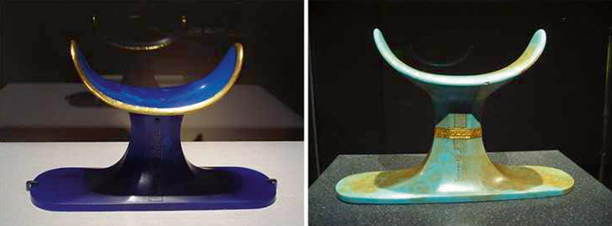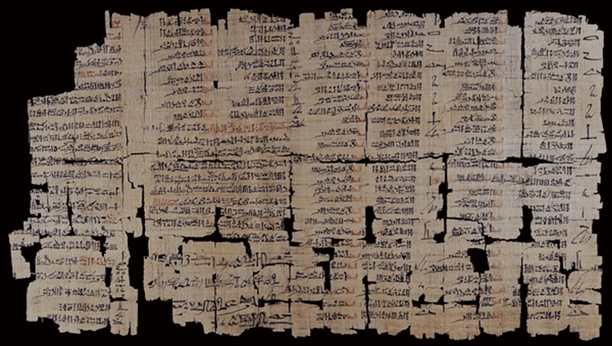This symbol may be pointing also to the state of consciousness that we call today lucid dreaming [3].
What Is the Meaning (Concept) of Sleep in Ancient Egyptian Culture?
Ancient Egyptians believed each person has five bodies [4]:
1.
ka = creative or divine power or the living physical body
2.
ba = soul, able to travel beyond the physical body
3.
akh or Shat = body of the deceased in the afterlife (the corpse body) which means the union of the ka and ba
4.
the name = living part of the person
5.
the shadow = another living part of the person
This description of multidimensional levels of the self has something to do with sleep, as the ancient Egyptians believed in the ability of the ba (soul) to travel beyond the physical body during sleep. The ba was represented in hieroglyphics as a human-headed bird floating above the sleeping body. In that sense, sleep was viewed to be similar, in some aspect, to death, in which the person is in a different state or a different world. Being strong believers in the afterlife, sleep was considered as a way or outlet to that mysterious world and a means through which a person can communicate with the dead as well as his gods. For this reason, it is not surprising to find some rituals related to sleep to resemble what is adopted in preparation for death [5].
The headrests used for the act of sleeping during life were most probably of a symbolic nature and were essential requirement for funeral—to be kept with the dead in his burial chamber, acting as a pillow for eternal sleep, ensuring the head remained physically intact with the body in the afterlife (Fig. 2.1). Thus, if the tomb represented the home for the deceased, the burial chamber represented the bedroom [6].
The idea that the dead were sleeping or that they occupied another dimension not totally disconnected from the living is indicated in letters to the dead written on papyrus or ostraca, including Coffin Texts. These Coffin Texts functioned as ritually protective spells and instructions, intended to ensure safe passage to the afterlife. In Coffin Text (CT) 74, it was written “Oh sleeper, turn about in this place which you do not know, but I know it. Come that we may raise his head. Come that we may reassemble his bones” [6].
How Were Dreams Dealt with by Ancient Egyptians?
The Importance of Dreams
Like many ancient cultures, the Egyptians put quite a bit of emphasis on dreams. They believed the gods could show themselves in dreams, delivering messages that could guide them in their lives, i.e., the received messages might cure an illness or help them make important decisions, to the point of deciding where to build a new temple or when to wage a war.
The Egyptians also believed that their dreams could serve as a window to see the activities of the dead. However, they often feared these types of dreams, being afraid that this could bring about unwanted evil spirits [7].
Types of Dreams
The records list three main types of dreams [8]:
1.
Those in which the gods would demand some pious act
2.
Those that contained warnings (perhaps about illness) or revelations
3.
Those that came about through ritual
Dream Incubation
Like other Near Eastern people, the Egyptians believed that the dreams could serve as oracles, bringing messages from the gods . The best way to get the desired answer, especially in sickness, was to induce or “incubate” dreams (Incubate comes from the Latin incubare, meaning to lie down upon). To incubate dreams, Egyptians would travel to a sanctuary or shrine, where they slept overnight on a special dream bed in the hope of receiving divine advice, comfort, or healing from their dreams. There were dream or sleep temples built specifically for this reason. The temples were open to everyone who believed in the god the temple was dedicated to, as long as they were considered pure. To achieve this, the person often went through a ritual of cleansing that included fasting and abstinence for several days prior to entering the temple to assure their purity. The name of the god the person hoped to contact at the temple was written on a piece of linen and that linen cloth was burned in a lamp while at the temple. To help call the god, the dreamer would often recite a special prayer to him or her. Once they visited the ancient Egyptian dream temple, the person would often go to a priest or dream interpreter for dream analysis [7].
Dream Analysis in Ancient Egypt (The Dream Book)
Because they put so much stock into dreams , it was important for Egyptians to be able to understand the significance and meaning of their dreams. Like many others, some Egyptians kept a dream book—a book that chronicled their dreams and the interpretation of them. One such dream book, written on papyrus, dates all the way back to approximately 1275 BC, during the reign of Ramesses II [9, 10] (Fig. 2.2).
It is believed that the ancient Egyptian dream book kept in the British Museum in London had many owners as it was passed down for more than a century. All in all, the dream book included 108 different dreams, which included such activities as weaving, stirring, seeing, eating, and drinking.
The dreams were categorized into good ( auspicious) dreams and bad ( inauspicious) dreams, with the bad dreams being written in red, a color of bad omens. In this book, there are hieratic signs that state such interpretations, as that it is good when a man dreams he sees himself looking out of a window. Even a man seeing himself dead was seen as a good sign, meaning that he would live a long life. However, if a man dreamed he saw his own face in a mirror it was a bad omen. Also, dreaming of putting your own face to the ground was seen as a bad omen. It was believed that that particular dream meant that the dead wanted something.
Qenherkhepshef’s dream book was a family affair; penned by his grandson, the scribe Amen-nakht, who was the son of Kha-em-nun, Qenherkhepshef’s oldest child . The texts allow insight, not only into the dreams of these ancient people but also into the everyday experiences of their lived lives.
Listing of Dreams in the Dream Book [9]:
The dream book is divided into lists of auspicious and inauspicious dreams:
a.




Auspicious dreams (good dreams)
Stay updated, free articles. Join our Telegram channel

Full access? Get Clinical Tree







